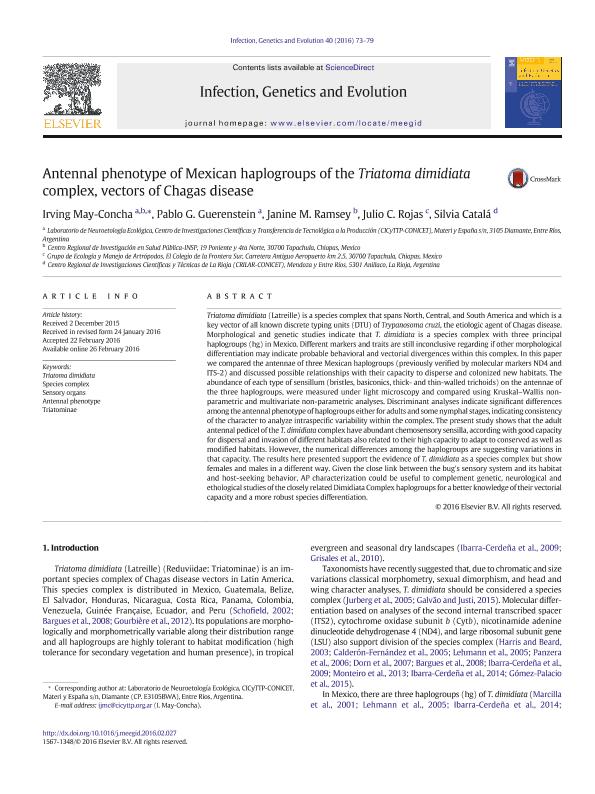Artículo
Antennal phenotype of Mexican haplogroups of the Triatoma dimidiata complex, vectors of Chagas disease
May Concha, Irving Jesus ; Guerenstein, Pablo Gustavo
; Guerenstein, Pablo Gustavo ; Ramsey, Janine; Rojas, Julio C.; Catala, Silvia Susana
; Ramsey, Janine; Rojas, Julio C.; Catala, Silvia Susana
 ; Guerenstein, Pablo Gustavo
; Guerenstein, Pablo Gustavo ; Ramsey, Janine; Rojas, Julio C.; Catala, Silvia Susana
; Ramsey, Janine; Rojas, Julio C.; Catala, Silvia Susana
Fecha de publicación:
02/2016
Editorial:
Elsevier Science
Revista:
Infection, Genetics and Evolution
ISSN:
1567-1348
Idioma:
Inglés
Tipo de recurso:
Artículo publicado
Clasificación temática:
Resumen
Triatoma dimidiata (Latreille) is a species complex that spans North, Central, and South America and which is a key vector of all known discrete typing units (DTU) of Trypanosoma cruzi, the etiologic agent of Chagas disease. Morphological and genetic studies indicate that T. dimidiata is a species complex with three principal haplogroups (hg) in Mexico. Different markers and traits are still inconclusive regarding if other morphological differentiation may indicate probable behavioral and vectorial divergences within this complex. In this paper we compared the antennae of three Mexican haplogroups (previously verified by molecular markers ND4 and ITS-2) and discussed possible relationships with their capacity to disperse and colonized new habitats. The abundance of each type of sensillum (bristles, basiconics, thick- and thin-walled trichoids) on the antennae of the three haplogroups, were measured under light microscopy and compared using Kruskal-Wallis non-parametric and multivariate non-parametric analyses. Discriminant analyses indicate significant differences among the antennal phenotype of haplogroups either for adults and some nymphal stages, indicating consistency of the character to analyze intraspecific variability within the complex. The present study shows that the adult antennal pedicel of the T. dimidiata complex have abundant chemosensory sensilla, according with good capacity for dispersal and invasion of different habitats also related to their high capacity to adapt to conserved as well as modified habitats. However, the numerical differences among the haplogroups are suggesting variations in that capacity. The results here presented support the evidence of T. dimidiata as a species complex but show females and males in a different way. Given the close link between the bug's sensory system and its habitat and host-seeking behavior, AP characterization could be useful to complement genetic, neurological and ethological studies of the closely related Dimidiata Complex haplogroups for a better knowledge of their vectorial capacity and a more robust species differentiation.
Archivos asociados
Licencia
Identificadores
Colecciones
Articulos(CICYTTP)
Articulos de CENTRO DE INV.CIENT.Y TRANSFERENCIA TEC A LA PROD
Articulos de CENTRO DE INV.CIENT.Y TRANSFERENCIA TEC A LA PROD
Articulos(CRILAR)
Articulos de CENTRO REGIONAL DE INV. CIENTIFICAS Y TRANSFERENCIA TECNOLOGICA DE ANILLACO
Articulos de CENTRO REGIONAL DE INV. CIENTIFICAS Y TRANSFERENCIA TECNOLOGICA DE ANILLACO
Citación
May Concha, Irving Jesus; Guerenstein, Pablo Gustavo; Ramsey, Janine; Rojas, Julio C.; Catala, Silvia Susana; Antennal phenotype of Mexican haplogroups of the Triatoma dimidiata complex, vectors of Chagas disease; Elsevier Science; Infection, Genetics and Evolution; 40; 2-2016; 73-79
Compartir
Altmétricas



